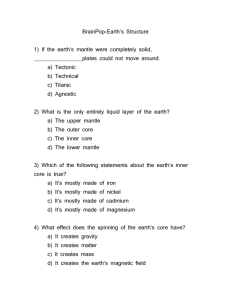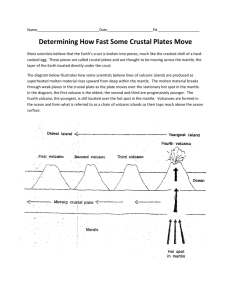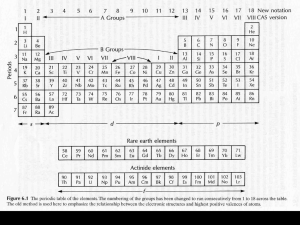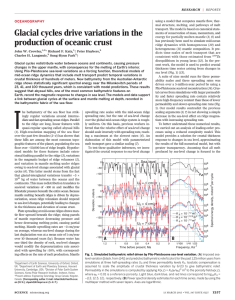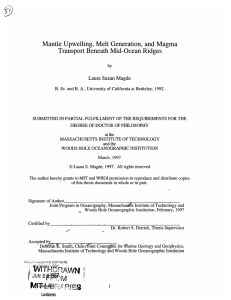R2K_2011_OceanographySpecialIssue_Abstract
advertisement
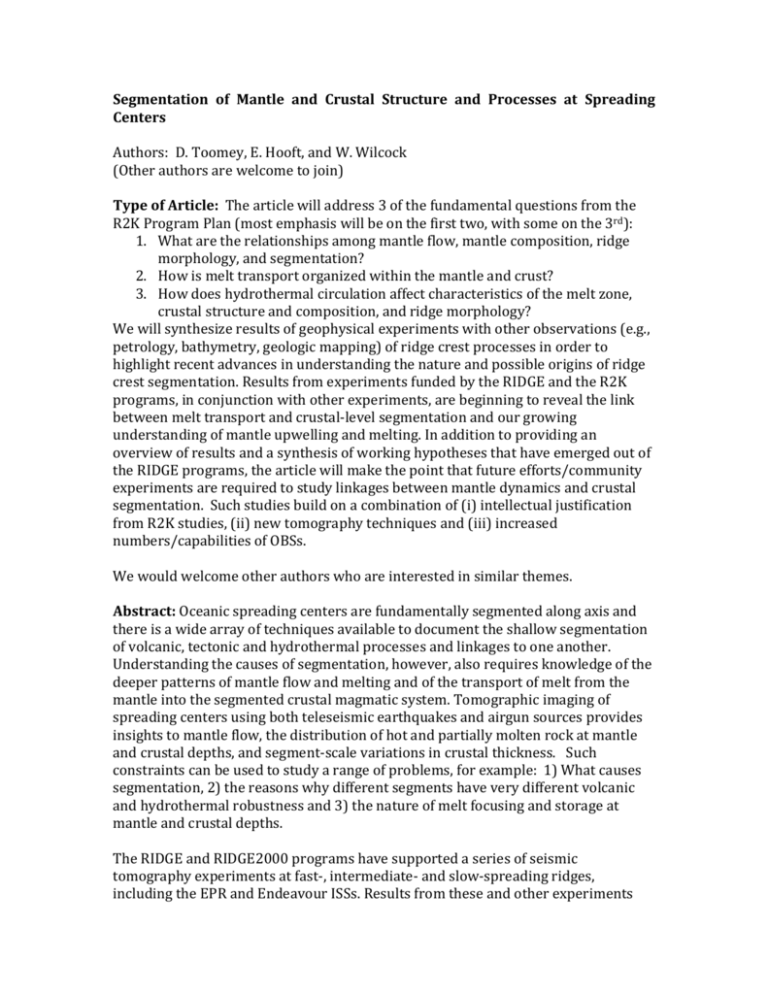
Segmentation of Mantle and Crustal Structure and Processes at Spreading Centers Authors: D. Toomey, E. Hooft, and W. Wilcock (Other authors are welcome to join) Type of Article: The article will address 3 of the fundamental questions from the R2K Program Plan (most emphasis will be on the first two, with some on the 3rd): 1. What are the relationships among mantle flow, mantle composition, ridge morphology, and segmentation? 2. How is melt transport organized within the mantle and crust? 3. How does hydrothermal circulation affect characteristics of the melt zone, crustal structure and composition, and ridge morphology? We will synthesize results of geophysical experiments with other observations (e.g., petrology, bathymetry, geologic mapping) of ridge crest processes in order to highlight recent advances in understanding the nature and possible origins of ridge crest segmentation. Results from experiments funded by the RIDGE and the R2K programs, in conjunction with other experiments, are beginning to reveal the link between melt transport and crustal-level segmentation and our growing understanding of mantle upwelling and melting. In addition to providing an overview of results and a synthesis of working hypotheses that have emerged out of the RIDGE programs, the article will make the point that future efforts/community experiments are required to study linkages between mantle dynamics and crustal segmentation. Such studies build on a combination of (i) intellectual justification from R2K studies, (ii) new tomography techniques and (iii) increased numbers/capabilities of OBSs. We would welcome other authors who are interested in similar themes. Abstract: Oceanic spreading centers are fundamentally segmented along axis and there is a wide array of techniques available to document the shallow segmentation of volcanic, tectonic and hydrothermal processes and linkages to one another. Understanding the causes of segmentation, however, also requires knowledge of the deeper patterns of mantle flow and melting and of the transport of melt from the mantle into the segmented crustal magmatic system. Tomographic imaging of spreading centers using both teleseismic earthquakes and airgun sources provides insights to mantle flow, the distribution of hot and partially molten rock at mantle and crustal depths, and segment-scale variations in crustal thickness. Such constraints can be used to study a range of problems, for example: 1) What causes segmentation, 2) the reasons why different segments have very different volcanic and hydrothermal robustness and 3) the nature of melt focusing and storage at mantle and crustal depths. The RIDGE and RIDGE2000 programs have supported a series of seismic tomography experiments at fast-, intermediate- and slow-spreading ridges, including the EPR and Endeavour ISSs. Results from these and other experiments allow us to compare and contrast mantle and crustal structure in settings with different spreading rates and plate motions. There are some remarkable observations: Oceanic asthenosphere is not well coupled to plate motion. For example, mantle divergence at fast-, intermediate- and slow-spreading ridges (EPR 9˚N, Endeavour, MAR 35˚N) is not aligned with the spreading direction. In the MELT region, Pacific asthenosphere is moving opposite the direction of plate motion. The implication of these results is that mantle upwelling beneath spreading centers is not simply a passive response to plate motion, thus many numerical and conceptual models are misleading. Similarly, the axis of mantle upwelling at the EPR, and possibly the MAR, is not aligned with the ridge axis. A recent experiment at the Endeavour segment will also constrain the location of the axis of mantle upwelling. One implication of these results is that the segmentation of spreading centers appears to be related to the skew of mantle upwelling. Melt focusing at fast- and intermediate-spreading ridges is not 100% efficient. At both the EPR and the Endeavour segment, off-axis crustal magma bodies have been detected up to 20 km from the rise axis. In the case of the Endeavour, there are numerous off-axis crustal-level magmatic intrusions that underlie off-axis ridges and constructional volcanic features. These results suggest that the final focusing of melt toward the rise axis is the result of the topology of oceanic lithosphere and that magmatic differentiation at mantle depths may play a fundamental role in controlling ridge crest activity. At fast-spreading ridges, along-axis variations in axial depth are the result of crustal density anomalies, which arise from systematic, along-axis variations in crystal fractionation depths. Whether or not this process is operative at slower spreading rates remains to be examined. The article would present a synthesis of previous studies with an emphasis on current working hypotheses for the connection between mantle dynamics and the segmentation of ridge crest processes. It would also underline the role of the R2K program in stimulating emerging initiatives to study mantle dynamics.




